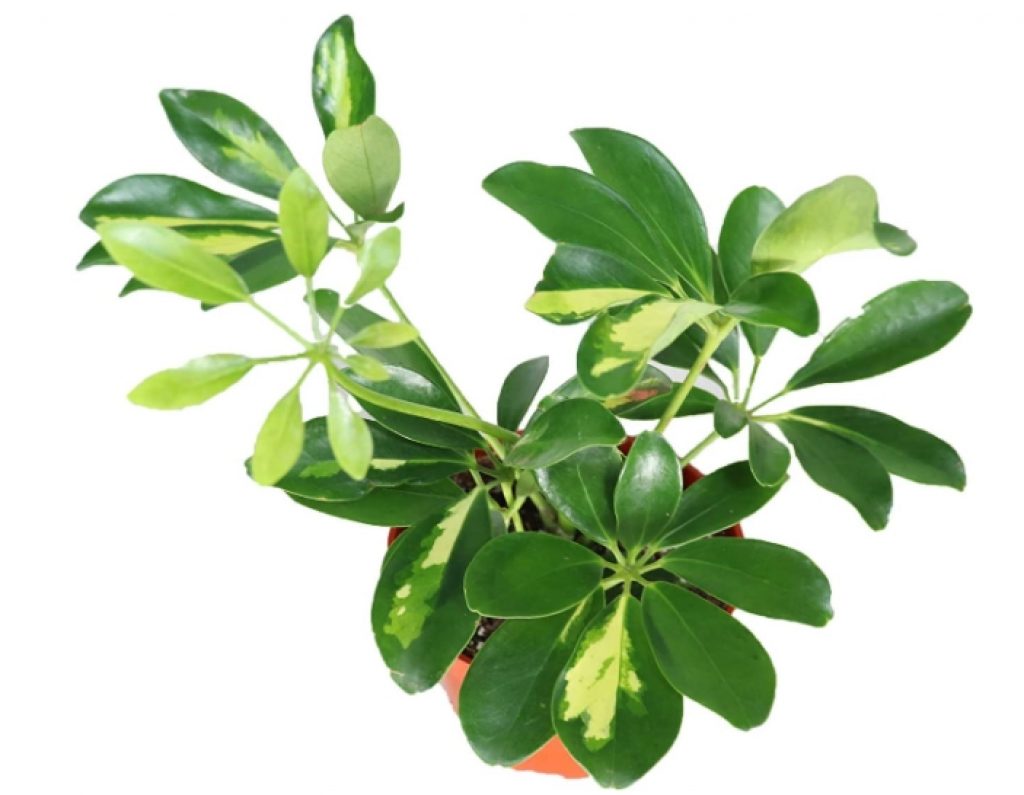Native to Taiwan and Hainan, Schefflera arboricola, commonly known as the dwarf umbrella tree due to its striking resemblance with the umbrella tree (Schefflera actinophylla), but it’s much smaller.
Depending on where you are, it may go for other names, including Australian ivy palm, dwarf Hawaiian Schefflera, Starleaf, Octopus tree, dwarf Schefflera, Hawaii umbrella tree, or parasol plant.

This evergreen subshrub in the family Araliaceae with many cultivars whose leaf color and pattern vary, with most being variegated with creamy-white centers or edges, makes a great houseplant (indoor bonsai) that will thrive in poor condition and neglect. You can also have it as a landscape plant so long as the frost isn’t severe, i.e., in mild climates.
Are they poisonous to cats?
Unfortunately, yes. Schefflera arboricola is toxic to cats since it has calcium sharp, needle-like oxalate crystals. These microscopic oxalate crystals are contained in specialized cells known as idioblasts.
When cats ingest the dwarf umbrella tree, their saliva will make idioblasts to rupture, allowing the oxalate crystals to escape and pierce their oral and digestive tract mucous membrane. As this happens, your cat will end up with symptoms such as “oral irritation, intense burning, and irritation of the mouth, lips, tongue, excessive drooling, vomiting, difficulty in swallowing,” notes ASPCA.
All parts (from root to leaves) of the varieties including Arboricola, Renate, Gold Capella, Trinette, and Dazzle are poisonous to cats and dogs and, if ingested in large amounts, may be fatal mainly if it damages the digestive tract. Also, these calcium crystals can potentially result in liver and kidney damage.
Furthermore, Wikipedia notes symptoms such as “cardiac arrhythmia, diarrhea, vomiting, dilated eyes, difficulty swallowing, excessive drooling, hoarse barking, labored breathing, loss of appetite, numbness of exposed area(s), obstruction of the airway, pawing/rubbing at the face or mouth and the swelling of the tongue and lips” in pets.
Finally, your feline may shake their head, show other signs of pain, convulsions, coma, or even death. If your cats have any of the above symptoms, take them to your veterinarian or call any animal poison helpline.
Protecting cats from dwarf umbrella tree
Cats may eat greeneries, including grass and plants, for various reasons. Therefore, the best way to avoid any instance of toxicity is not buying Schefflera arboricola or any other toxic houseplants.
However, if you love the plant and prefer to keep it, some ways to prevent accidental ingestion by your cats include the following:
- Having a plant terrarium, especially one made of glass, will ensure your plant remains visible but inaccessible by your kitty. Amazon has many brands for you.
- Try cat repellents such as PetSafe SSSCAT Spray Dog and Cat Deterrent, Motion Activated Pet Repellent, or any other good brand.
- Consider making the plant less appealing by spraying it with cayenne pepper or any other homemade feline repellent. This way, your cat won’t want to eat it.
- Suppose you have them in your garden or as landscaping plants. In that case, you can use a cat-proof fence, outdoor repellent, as well as deterrents like Llfaiww Dog Repellent, Ultrasonic Animal Repellent with Motion Sensor, and Flashing Lights Outdoor Solar Powered.
Other ways include giving them alternative safe plants and cat grass and covering the planter with aluminum foil (cats don’t like the sound and feeling it has on their paws). Also, placing it in places your cat doesn’t frequent often, having sharp rocks, and minimizing boredom (reduces plant-eating).
Finally, don’t forget to pick any fallen petals, stems, or leaves of your dwarf umbrella tree or any other unsafe one.
Other harmful houseplants
Besides arboricola, other toxic house plants include the following:
- Amaryllis
- Azaleas
- Chrysanthemum
- Daffodils
- Lilies
- Aloe vera
- Monstera Deliciosa
- Pothos
- Jade plants
- Snake plants
- Sago palm
- English ivy
- Tulips
- Poinsettias
The list of houseplants toxic to cats and dogs is endless. Therefore, always check on safety before you buy any kind.
